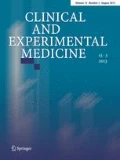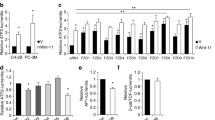Abstract
Hedgehog (Hh) signaling is an essential pathway in embryonic development of prostate. Hh also plays roles in the proliferation of progenitor cells and cancer cells of adult prostate. However, how Hh signaling contributes to carcinogenesis of prostate is poorly understood. Stathmin1 is a microtubule-regulating protein that plays an important role in the assembly and disassembly of the mitotic spindle. Stathmin1 is expressed in normal developing mouse prostate and in prostate cancer. The expression pattern of stathmin1 is similar to that of Shh in prostate development and cancer, suggesting a connection between these two proteins. In this study, we examined the relationship between stathmin1 and Hh signaling. Here, we show that stathmin1 expression is regulated by Hh signaling in prostate cancer cells. Cyclopamine, a specific inhibitor of Hh signaling, reduced the expression of stathmin1 in prostate cancer cells. However, the Shh peptide induced stathmin1 expression. Overexpression of Gli1 further confirmed the relationship. Co-expression of stathmin1 and Patched 1, a receptor for Hh signaling was observed in prostate cancer tissues. Cyclopamine and stathmin1 siRNA both decreased proliferation of prostate cancer cells but did not produce an additive effect, suggesting a common pathway. These results suggest that Hh signaling regulates proliferation of prostate cancer cells by controlling stathmin1 expression.





Similar content being viewed by others
References
Gurel B, Iwata T, Koh CM, Yegnasubramanian S, Nelson WG, De Marzo AM (2008) Molecular alterations in prostate cancer as diagnostic, prognostic, and therapeutic targets. Adv Anat Pathol 15(6):319–331
Jones MJ, Koeneman KS (2008) Local-regional prostate cancer. Urol Oncol 26(5):516–521
Belmont LD, Mitchison TJ (1996) Identification of a protein that interacts with tubulin dimers and increases the catastrophe rate of microtubules. Cell 84(4):623–631
Marklund U, Larsson N, Gradin HM, Brattsand G, Gullberg M (1996) Oncoprotein 18 is a phosphorylation-responsive regulator of microtubule dynamics. EMBO J 15(19):5290–5298
Mistry SJ, Atweh GF (2001) Stathmin inhibition enhances okadaic acid-induced mitotic arrest: a potential role for stathmin in mitotic exit. J Biol Chem 276(33):31209–31215
Mistry SJ, Atweh GF (2006) Therapeutic interactions between stathmin inhibition and chemotherapeutic agents in prostate cancer. Mol Cancer Ther 5(12):3248–3257
Mistry SJ, Li HC, Atweh GF (1998) Role for protein phosphatases in the cell-cycle-regulated phosphorylation of stathmin. Biochem J 334(Pt 1):23–29
Brattsand G (2000) Correlation of oncoprotein 18/stathmin expression in human breast cancer with established prognostic factors. Br J Cancer 83(3):311–318
Melhem RF, Strahler JR, Hailat N, Zhu XX, Hanash SM (1991) Involvement of OP18 in cell proliferation. Biochem Biophys Res Commun 179(3):1649–1655
Friedrich B, Gronberg H, Landstrom M, Gullberg M, Bergh A (1995) Differentiation-stage specific expression of oncoprotein 18 in human and rat prostatic adenocarcinoma. Prostate 27(2):102–109
Chen G, Wang H, Gharib TG, Huang CC, Thomas DG, Shedden KA, Kuick R, Taylor JM, Kardia SL, Misek DE et al (2003) Overexpression of oncoprotein 18 correlates with poor differentiation in lung adenocarcinomas. Mol Cell Proteomics 2(2):107–116
Singer S, Ehemann V, Brauckhoff A, Keith M, Vreden S, Schirmacher P, Breuhahn K (2007) Protumorigenic overexpression of stathmin/Op18 by gain-of-function mutation in p53 in human hepatocarcinogenesis. Hepatol 46(3):759–768
Marigo V, Tabin CJ (1996) Regulation of patched by sonic hedgehog in the developing neural tube. Proc Natl Acad Sci USA 93(18):9346–9351
Bellusci S, Furuta Y, Rush MG, Henderson R, Winnier G, Hogan BL (1997) Involvement of Sonic hedgehog (Shh) in mouse embryonic lung growth and morphogenesis. Development 124(1):53–63
Chiang C, Swan RZ, Grachtchouk M, Bolinger M, Litingtung Y, Robertson EK, Cooper MK, Gaffield W, Westphal H, Beachy PA et al (1999) Essential role for Sonic hedgehog during hair follicle morphogenesis. Dev Biol 205(1):1–9
Chiang C, Litingtung Y, Lee E, Young KE, Corden JL, Westphal H, Beachy PA (1996) Cyclopia and defective axial patterning in mice lacking Sonic hedgehog gene function. Nature 383(6599):407–413
Vortkamp A, Lee K, Lanske B, Segre GV, Kronenberg HM, Tabin CJ (1996) Regulation of rate of cartilage differentiation by Indian hedgehog and PTH-related protein. Science 273(5275):613–622
Litingtung Y, Lei L, Westphal H, Chiang C (1998) Sonic hedgehog is essential to foregut development. Nat Genet 20(1):58–61
Motoyama J, Liu J, Mo R, Ding Q, Post M, Hui CC (1998) Essential function of Gli2 and Gli3 in the formation of lung, trachea and oesophagus. Nat Genet 20(1):54–57
Ramalho-Santos M, Melton DA, McMahon AP (2000) Hedgehog signals regulate multiple aspects of gastrointestinal development. Development 127(12):2763–2772
Leow CC, Wang BE, Ross J, Chan SM, Zha J, Carano RA, Frantz G, Shen MM, de Sauvage FJ, Gao WQ (2009) Prostate-specific Klf6 inactivation impairs anterior prostate branching morphogenesis through increased activation of the Shh pathway. J Biol Chem 284(31):21057–21065
Freestone SH, Marker P, Grace OC, Tomlinson DC, Cunha GR, Harnden P, Thomson AA (2003) Sonic hedgehog regulates prostatic growth and epithelial differentiation. Dev Biol 264(2):352–362
Wang BE, Shou J, Ross S, Koeppen H, De Sauvage FJ, Gao WQ (2003) Inhibition of epithelial ductal branching in the prostate by sonic hedgehog is indirectly mediated by stromal cells. J Biol Chem 278(20):18506–18513
Berman DM, Desai N, Wang X, Karhadkar SS, Reynon M, Abate-Shen C, Beachy PA, Shen MM (2004) Roles for Hedgehog signaling in androgen production and prostate ductal morphogenesis. Dev Biol 267(2):387–398
Lamm ML, Catbagan WS, Laciak RJ, Barnett DH, Hebner CM, Gaffield W, Walterhouse D, Iannaccone P, Bushman W (2002) Sonic hedgehog activates mesenchymal Gli1 expression during prostate ductal bud formation. Dev Biol 249(2):349–366
Taylor MD, Liu L, Raffel C, Hui CC, Mainprize TG, Zhang X, Agatep R, Chiappa S, Gao L, Lowrance A et al (2002) Mutations in SUFU predispose to medulloblastoma. Nat Genet 31(3):306–310
Xie J, Murone M, Luoh SM, Ryan A, Gu Q, Zhang C, Bonifas JM, Lam CW, Hynes M, Goddard A et al (1998) Activating Smoothened mutations in sporadic basal-cell carcinoma. Nature 391(6662):90–92
Watkins DN, Berman DM, Burkholder SG, Wang B, Beachy PA, Baylin SB (2003) Hedgehog signalling within airway epithelial progenitors and in small-cell lung cancer. Nature 422(6929):313–317
Kubo M, Nakamura M, Tasaki A, Yamanaka N, Nakashima H, Nomura M, Kuroki S, Katano M (2004) Hedgehog signaling pathway is a new therapeutic target for patients with breast cancer. Cancer Res 64(17):6071–6074
Karhadkar SS, Bova GS, Abdallah N, Dhara S, Gardner D, Maitra A, Isaacs JT, Berman DM, Beachy PA (2004) Hedgehog signalling in prostate regeneration, neoplasia and metastasis. Nature 431(7009):707–712
Peacock CD, Wang Q, Gesell GS, Corcoran-Schwartz IM, Jones E, Kim J, Devereux WL, Rhodes JT, Huff CA, Beachy PA et al (2007) Hedgehog signaling maintains a tumor stem cell compartment in multiple myeloma. Proc Natl Acad Sci USA 104(10):4048–4053
Ghosh R, Gu G, Tillman E, Yuan J, Wang Y, Fazli L, Rennie PS, Kasper S (2007) Increased expression and differential phosphorylation of stathmin may promote prostate cancer progression. Prostate 67(10):1038–1052
Kim MJ, Bhatia-Gaur R, Banach-Petrosky WA, Desai N, Wang Y, Hayward SW, Cunha GR, Cardiff RD, Shen MM, Abate-Shen C (2002) Nkx3.1 mutant mice recapitulate early stages of prostate carcinogenesis. Cancer Res 62(11):2999–3004
Bhatia-Gaur R, Donjacour AA, Sciavolino PJ, Kim M, Desai N, Young P, Norton CR, Gridley T, Cardiff RD, Cunha GR et al (1999) Roles for Nkx3.1 in prostate development and cancer. Genes Dev 13(8):966–977
Lee JJ, von Kessler DP, Parks S, Beachy PA (1992) Secretion and localized transcription suggest a role in positional signaling for products of the segmentation gene hedgehog. Cell 71(1):33–50
Mohler J, Vani K (1992) Molecular organization and embryonic expression of the hedgehog gene involved in cell–cell communication in segmental patterning of Drosophila. Development 115(4):957–971
Tabata T, Eaton S, Kornberg TB (1992) The Drosophila hedgehog gene is expressed specifically in posterior compartment cells and is a target of engrailed regulation. Genes Dev 6(12B):2635–2645
Echelard Y, Epstein DJ, St-Jacques B, Shen L, Mohler J, McMahon JA, McMahon AP (1993) Sonic hedgehog, a member of a family of putative signaling molecules, is implicated in the regulation of CNS polarity. Cell 75(7):1417–1430
Krauss S, Concordet JP, Ingham PW (1993) A functionally conserved homolog of the Drosophila segment polarity gene hh is expressed in tissues with polarizing activity in zebrafish embryos. Cell 75(7):1431–1444
Riddle RD, Johnson RL, Laufer E, Tabin C (1993) Sonic hedgehog mediates the polarizing activity of the ZPA. Cell 75(7):1401–1416
Beachy PA, Karhadkar SS, Berman DM (2004) Tissue repair and stem cell renewal in carcinogenesis. Nature 432(7015):324–331
Duman-Scheel M, Weng L, Xin S, Du W (2002) Hedgehog regulates cell growth and proliferation by inducing Cyclin D and Cyclin E. Nature 417(6886):299–304
Li Y, Zhang H, Choi SC, Litingtung Y, Chiang C (2004) Sonic hedgehog signaling regulates Gli3 processing, mesenchymal proliferation, and differentiation during mouse lung organogenesis. Dev Biol 270(1):214–231
Yoon JW, Kita Y, Frank DJ, Majewski RR, Konicek BA, Nobrega MA, Jacob H, Walterhouse D, Iannaccone P (2002) Gene expression profiling leads to identification of GLI1-binding elements in target genes and a role for multiple downstream pathways in GLI1-induced cell transformation. J Biol Chem 277(7):5548–5555
Barnes EA, Kong M, Ollendorff V, Donoghue DJ (2001) Patched1 interacts with cyclin B1 to regulate cell cycle progression. EMBO J 20(9):2214–2223
Fan H, Khavari PA (1999) Sonic hedgehog opposes epithelial cell cycle arrest. J Cell Biol 147(1):71–76
Rana S, Maples PB, Senzer N, Nemunaitis J (2008) Stathmin 1: a novel therapeutic target for anticancer activity. Expert Rev Anticancer Ther 8(9):1461–1470
Wei SH, Lin F, Wang X, Gao P, Zhang HZ (2008) Prognostic significance of stathmin expression in correlation with metastasis and clinicopathological characteristics in human ovarian carcinoma. Acta Histochem 110(1):59–65
Wong QW, Lung RW, Law PT, Lai PB, Chan KY, To KF, Wong N (2008) MicroRNA-223 is commonly repressed in hepatocellular carcinoma and potentiates expression of Stathmin1. Gastroenterology 135(1):257–269
Benlhabib H, Herrera JE (2006) Expression of the Op18 gene is maintained by the CCAAT-binding transcription factor NF-Y. Gene 377:177–185
Ahn J, Murphy M, Kratowicz S, Wang A, Levine AJ, George DL (1999) Down-regulation of the stathmin/Op18 and FKBP25 genes following p53 induction. Oncogene 18(43):5954–5958
Johnsen JI, Aurelio ON, Kwaja Z, Jorgensen GE, Pellegata NS, Plattner R, Stanbridge EJ, Cajot JF (2000) p53-mediated negative regulation of stathmin/Op18 expression is associated with G(2)/M cell-cycle arrest. Int J Cancer 88(5):685–691
Acknowledgments
This study was supported by Medical Research Institute Grant (2005-50), Pusan National University, the Korea Research Foundation Grant funded by the Korean Government (MOEHRD, Basic Research Promotion Fund) (KRF-2008-331-E00047), and a grant from the National R&D Program for Cancer Control, Ministry for Health, Welfare and Family affairs, Republic of Korea (090230).
Conflict of interest statement
All authors declare to have no conflict of interest related to the publication of this manuscript.
Author information
Authors and Affiliations
Corresponding author
Additional information
M.-K. Chung and H.-J. Kim have contributed equally to this study.
Rights and permissions
About this article
Cite this article
Chung, MK., Kim, HJ., Lee, YS. et al. Hedgehog signaling regulates proliferation of prostate cancer cells via stathmin1. Clin Exp Med 10, 51–57 (2010). https://doi.org/10.1007/s10238-009-0068-7
Received:
Accepted:
Published:
Issue Date:
DOI: https://doi.org/10.1007/s10238-009-0068-7




